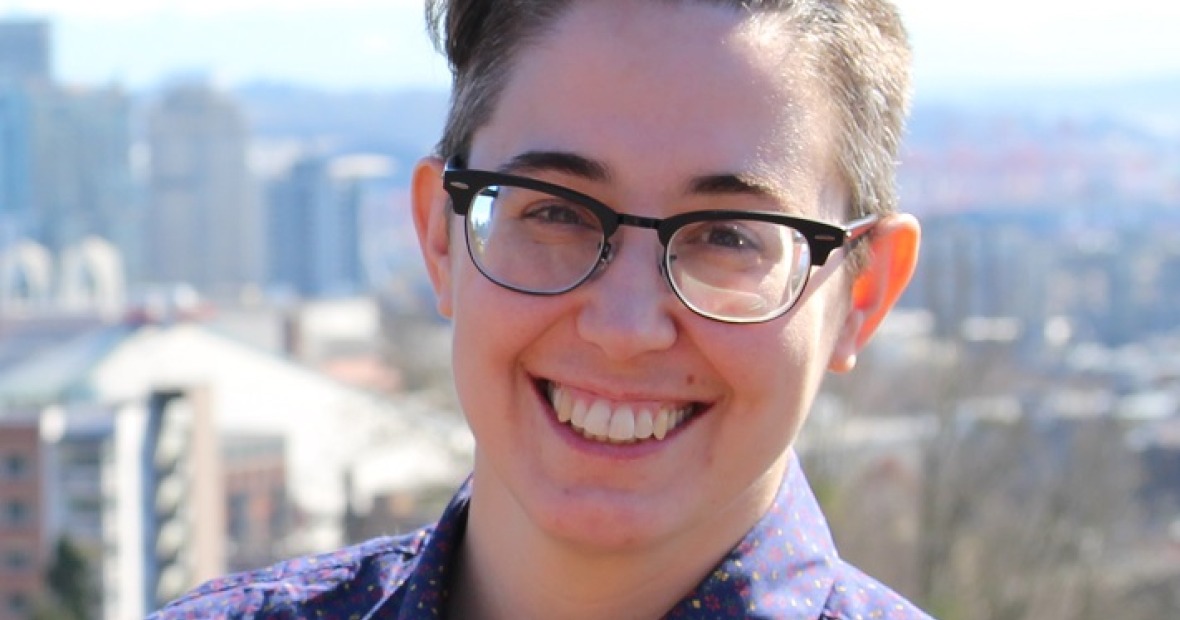5 Questions with Sarah Barks
Sarah Barks, senior director, STEM career communities and analytics in the Center for Careers, Life, and Service (CLS), leads the Science, Engineering, and Sustainability, and Technology and Data Career Communities at Grinnell. They joined the CLS team in 2014 and serve as a mentor and adviser to Grinnell students and early-career alumni on experiential learning opportunities and targeted programming that help them achieve their postgraduate goals. Sarah also manages data and analytics for the CLS, tracking student engagement and graduate outcomes. They are married to Lauren Myers, a member of Grinnell’s Academic Advising team, and the couple share space in Grinnell with an “absurd dog named Lou and a perfect cat named Francie.”
Q: Where did you live before coming to Grinnell?

A: I grew up in Hermann, Missouri, which is even smaller than Grinnell. I then moved to St. Louis to attend college at Washington University (BA in anthropology and cognitive neuroscience), then Atlanta for graduate school at Emory University (PhD in biological anthropology). I also lived in Washington D.C. where I was a post-doctoral scientist at George Washington University.
Q: What does your role at Grinnell entail?
A: My role is two-fold. First, I help students and alumni navigate the path from Grinnell to careers in STEM fields. I work with students across the sciences as they apply for internships, summer research, graduate programs, and post-grad jobs. It’s a treat to help students explore alumni outcomes and see all the places a Grinnell education might take them. Second, I’m the CLS’s chief data wrangler. I track graduate outcomes and student engagement with our advisers and programs. I am a total sucker for any project using data in the CLS, such as analyzing our graduate outcomes or looking for patterns in students’ use of our services. If I can put something in a spreadsheet, I’m happy.
Q: What do you do when you’re not working?
A: I love books, podcasts, spoiling my pets, and crossword puzzles. I bake a lot — favorites are pie and sourdough bread. I take the same investigative approach to those hobbies as I do to my work, learning about the science of baking and endlessly tweaking my process. In the last year I’ve gotten kind of obsessed with climbing — shout-out to GORP and the crew at the Bear climbing wall!
Q: What has your experience been like working with Grinnellians?
A: Grinnellians are never, ever boring. I’ve been impressed from the start by our students’ ambition and creativity. I particularly love the interdisciplinary paths Grinnellians take: the studio art and biology double major who pursues medical illustration; the computer science and English major who uses machine learning for text analysis; the physics major who applies the study of optics to a photography hobby.
I’ve also found my experience as a researcher to be very helpful as I work with students. Grinnell students come up with all kinds of post-graduate goals and interests, and I get to use my research skills to figure out the best way to support them. I can tell students first-hand that the ability to find and synthesize a lot of information is going to be valuable in any job. My research work was also highly collaborative; my co-authors spanned institutions and countries. That skill in teamwork helps me work broadly with campus partners to support students.
Q: Can you tell us more about your research with great apes?
A: My graduate work was with chimpanzees at the Yerkes National Primate Research Center (affiliated with Emory University). I conducted functional neuroimaging studies of chimpanzees’ social cognition. A lot of research about human brain function had begun to suggest that humans default to social cognition at rest, i.e., when we are not engaged in a task and we’re just zoning out, we tend to think about social situations. My dissertation study demonstrated that chimpanzees do the same thing, at least to some degree. Working with chimps was incredibly challenging but so rewarding. I miss them a lot.
In my postdoc at the Center for the Advanced Study of Human Paleobiology (at The George Washington University), I shifted to neuroanatomy work with a particular focus on mountain gorillas. I was able to study the brains from the wild mountain gorillas that had been studied by Dian Fossey. It’s the only collection of wild great ape brains available for research anywhere in the world. We correlated features of these gorillas’ brains with their ecology and behavior, distinct from other gorilla species.
Bonus Question: What is your favorite Grinnell moment to date?
A: The best moments are always celebrating students’ success. Spring is a great time of year because I get to hear about grad school acceptances, job offers, and exciting internships. One highlight is the time a student who’d gotten into their top-choice grad program sent me a thank-you message on a potato. Like I said … Grinnellians are never boring.

